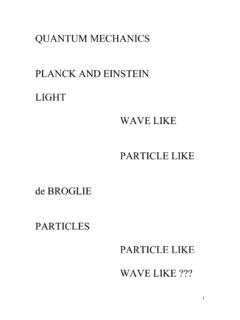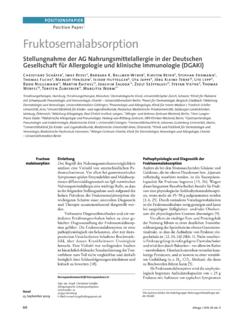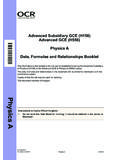Transcription of 1 Problem 9 - Physics and Astronomy at TAMU
1 1 Problem configuration has a greater number of unpaired spins? Which one hasa lower energy? [Kr]4d95s1or [Kr]4d10. What is the element and how doesHund s rule apply? SolutionThe element is Pd. The configuration [Kr]4d10has a lower energy, but a highernumber of unpaired spins. This is due to filled subshells having a lower is one of the cases where Hund s rule is Problem answer (except forZ= 19) can be seen in Figure 1. All credit to McGraw-Hill for the 1: The spin configurations forZ= 11 throughZ= 18. All credit toMcGraw-Hill for the imageForZ= 19, the additional electron will occupy the 4ssubshell, giving acondensed configuration of [Ar]4s1. The image will look just like before, butnow there s a 4sblock on the right with one arrow in Problem is the average temperature of plasma, which is formed by ionized atoms?
2 SolutionHere we actually use a result from stat mech, that for a monatomic gas K=32kTWherekis Boltzmann s constant. For the atoms to be ionized, the averagetemperature must be on the order such that they have enough energy for theelectrons to constantly be getting kicked loose. We see that the typical ionizationenergy is 5 eV. Since Boltzmann s constant is 10 5eV, we see that we musthave a temperature ofT Exercise (a) Show thatn(E)dE=2 NV( kT)3/2E1/2e EkTdE(b) Show that E= Part (a)Start with the Maxwell-Boltzmann distribution for velocity:n(v)dv=4 NV(m2 kT)3/2v2e mv22kTdvRemember that for kinetic energy, we haveE=12mv2 Taking the derivative of both sides givesdEdv=mv 1mvdE=dvPlugging these in givesn(E,v)dE=4 NV(m2 kT)3/2vme EkTdETo get rid of that remainingvwe rearrange the definition of kinetic energyto get2v= 2 EmPlugging this in givesn(E)dE=4 NV(m2 kT)3/2 2Em3e EkTdEThem s cancel out.
3 If we cancel out some of the 2 s as well, we will getn(E)dE=2 NV( kT)3/2E1/2e EkTdEas Part (b)In this section, we use E= 0En(E)dEWhich becomes E=2 NV( kT)3/2 0E3/2e EkTdESolving the integral gives E=2 NV( kT)3/2(kT)5/234 dEThis just simplifies to E=32 NkTVas Problem that the most probable speed for a particle in a Maxwell-Boltzmann dis-tribution isvmp= SolutionIn the Maxwell-Boltzmann distribution, the likelihood of finding a particle witha particular velocityv(per unit volume) is given byn(v)dv=4 NV(m2 kT)3/2v2e mv22kTdvThe way to maximize any function is to find where its derivative is (v) = 0 Throwing out the constants out front, this turns into0 =ddvv2e mv22kTMake sure to remember the chain rule0 = 2ve mv22kT+v2( m2kT2v)e mv22kTCanceling some terms out gives1 =v2m2kTSolving forv(and only keeping the positive root, a negative speed makes nosense) givesvmp= 2kTm6 Problem molecule with a dipole moment~pis placed in an external electric field,~.
4 Themolecule can only be parallel or antiparallel to the field.(a) Show that there are two allowed energy states separated by 2p .(b) Let the ground state have energy 0. The fraction of degeneracies betweenthe excited and ground states is 2. If there areNparticles at temperatureT,what is the ratio of particle sin the excited state to the ground state?(c) Find the temperature for which this ratio is Estimatep 10 30C mand 106V/m.(d) Calculate Efor some temperatureT. Show that E 0 asT 0 and E 4p 3asT (e) What isEtotal? Show that the heat capacity isC=(Nk2)(2p kT)2(exp[2p /kT](1 + exp[2p /kT])2)(f) SketchC. Where is it maximized? Explain the relationship in Part (a)We know that there are only two states because there are only two allowedorientations of the molecule: parallel and anti parallel. The energy of thesestates is given byE= ~p ~ We can see thatEparallel= p andEantiparallel=p So their difference will be E= 2p Part (b)The ratio of molecules in the excited state to the ground state is defined asR=g(2p )PMB(2p )g(0)PMB(0)The probability that a state is occupied is given byPMB(E) =Ae EkTThe constant out front will cancel out when we take the ratio.
5 Alsoe0= 1givingR= 2e 2p Part (c)Solving forTgivesT= 2p kln(R2)Plugging in the given values yieldsT= 2(10 30)(106) 10 23ln( ) Part (d)Since we are working with a two level system, we cannot use the integral def-inition of average. We must instead use the discrete definition. Since we aredealing with a Maxwell-Boltzmann distribution, the probability that a particlewill be found in a state with energyEiisP(Ei) =Ae EikTWe still have the normalization condition that1 = ig(Ei)P(Ei)Notice that we are careful to include degeneracy. In our case, this reducesto1 =Ae0+ 2Ae 2p /kTWe can use this to solve for A, givingA=11 + 2e 2p /kTNow we can use the discrete definition of average to get our answer E= ig(Ei)P(Ei)EiIn our case we have E=AE0(0) +A(4p )e 2p /kTThis becomes E=(4p )e 2p /kT1 + 2e 2p /kTDividing the top and bottom by 2e 2p /kTgives E=2p 1 +12e2p /kTIf we letT 0, then the denominator erupts, and we get E= the other hand, if we letT , then the exponential goes to 1.
6 Fromhere it s just a little algebra to get E=43p . Part (e)First we haveEtotal=N EThen we haveC=ddTEtotalNow the fun begins. Make sure to be careful with the chain rule!C=ddTN2p 1 +12e2p /kTC=N2p ( 1)(1 +12e2p /kT)2(12e2p /kT)(2p k( T 2))Rearranging this around a bit, we can get the answer from the bookC=Nk2(2p kT)2e2p /kT(1 +12e2p /kT) Part (f)Let s letz=2p kTThis makesC(z) =Nk2z2ez(1 +12ez)2 From here, there are two ways to proceed. You can find the maximum thehard way, by using the chain rule, or by graphing the function. Let s choosethe later. Wolfram Alpha plotted the function and tells us that the maximumvalue is at Problem the result from Exercise (E)dE=2 NV( kT)3/2E1/2e EkTdEFind:(a) the most probable energy(b) the average energy(c) the rms 2: Plot ofC(z) done by Wolfram Part (a)The way to maximize any function is to find where its derivative is (E) = 0We can throw away the constants out front to getddEE1/2e EkT= 0 Using the chain rule, we get12E 1/2e EkT+E1/2( 1kT)e EkT= 0 Canceling out the exponential, consolidating theEterms gives1 =2 EmpkTSolving forEmpgivesEmp= Part (b)The average energy is given by E=VN 0En(E)dE8Or E=VN2 NV( kT)3/2 0E3/2e EkTdESolving the integral gives E=2 ( kT)3/2(kT)5/234 dESimplifying E=32kTThis is essentially the same Problem as Exercise Part (b).
7 I apologizefor the redundancy. At least you could have just copied your own Part (c)To find the rms energy, we must first find the average of the square of the energy E2=VN 0E2n(E)dEOr E2=VN2 NV( kT)3/2 0E5/2e EkTdESolving the integral gives E2=2 ( kT)3/2(kT)7/2158 Simplifying gives E2= (kT)2154 This means that ourErmswill beErms= 154kT8 Problem the average photon energy in a Bose-Einstein gas at(a) TemperatureT(b)T= SolutionFor a Bose-Einstein gas, we haven(E)dE=8 E2(hc)31eE/kT 1dEThe average energy per photon is given by E= 0En(E)dE 0n(E)dEIf we plug inn(E)dEwe will see that all of the messy constants cancel out E= 0E31eE/kT 1dE 0E21eE/kT 1dEIf we letz=EkT, then we also haveE=kTzanddE=kTdz. Pluggingthese in gives E=(kT)4 0z31ez 1dz(kT)3 0z21ez 1dzPlugging in the formulae in the book gives E= 4kT15 Part (b)Here we useT= 6,000 K andk= 10 5eV/K E= 4( 10 5 600015 actually fits in well with our calculation of ionization energies of plasmain Problem These photons aren t hot enough to ionize gasses, but they renot too far off (Eion 5eV) and we predicted an ionization temperature of Problem that the average kinetic energy in a Fermi gas is SolutionFor a Fermi gas we haven(E)dE=8 2 m3/2eE1/2h31e(E EF)/kT+ 1dEThe average energy per electron is given by E= 0En(E)dE 0n(E)dEIf we plug inn(E)dEwe will see that all of the messy constants cancel out E= 0E3/21e(E EF)/kT+1dE 0E1/21e(E EF))
8 /kT+1dENow we must remember that at 0 K, the Fermi Dirac distribution goes tozero for energies above the Fermi energy. It goes to 1 for energies below theFermi energy. E= EF0E3/2dE EF0E1/2dENeither of these integrals is too tricky. They work out so that E=25E5/2F23E3/2 FOr simplifying E=35EF10 Problem the probability that an electron in Cu at 300 K has an energy equalto 99% of the Fermi SolutionFor a Fermi gas we havePFD(E)dE=1e(E EF)/kT+ 1dEWe are curious aboutEc=.99EF, soPFD(Ec)dE=1e + 1dE11 Plugging inEF= eV for Cu,T= 300K, andk= 10 5eV/K, wewill getPFD(Ec)dE=1e ( )/(300 10 5)+ 1dE it is very likely that this energy will be Additional Problem SolutionSee Figure 3 for the solution. There are 24= 16 possible 4 + 1 = 5 macrostates. The macrostates are divided up using lines. Theprobabilities of each macrostate are in the rightmost column.
9 The multiplicityof the macrostate can be gotten by multiplying the probability by equation for checking each macrostate is (n) =N!n!(N n)!For each of the cases these are (0) =4!0!(4 0)!=4!0!4!= 1 (1) =4!1!(4 1)!=4!1!3!= 4 (2) =4!2!(4 2)!=4!2!2!= 6 (3) =4!3!(4 3)!=4!3!1!= 4 (4) =4!4!(4 4)!=4!4!0!= 1 Yes, these numbers Additional Problem Part (a)There are 250 1015possible 3: The possible outcomes from tossing 4 coins. Credit to B. Wagner formaking the Part (b)We using the multiplicity formula again (n) =N!n!(N n)!In our case (25) =50!25!25! Part (c)The probability of gettingnheads is given by13P(n) = (n) (all)So for us it will work out to beP(25) =50!25!25! 250 Part (d)The multiplicity of getting 30 heads is (30) =50!30!(20)!This means the probability of getting 30 heads isP(30) =50!30!(20)! 250 Part (e)The multiplicity of getting 40 heads is (40) =50!
10 40!(10)!This means the probability of getting 40 heads isP(40) =50!40!(10)! 250 10 Part (f)The multiplicity of getting 50 heads is (50) =50!50!0!= 1 This means the probability of getting 40 heads isP(50) =1250 10 16 This is only from flipping 50 coins, and there is already a difference in 15orders of magnitude between the most and least likely state. Imagine how sharpthis gets when you have 1023coins ( particles)!1413 Addition Problem SolutionThis one you can just plug into your favorite calculator. The point is to justgive you a sense of scale. It works out so thatx 1010,000,000, s insanely huge!15












